Metrics Indicators And Classifications In
Abstract
There 2 neighboring villages where the intervention for the problem of malnutrition was conducted in rural South Africa. The intervention was related to research-led nutritional supplementation that targets infants in the age group of 6-18 months of age. The impact of the intervention was largely positive except for the participants’ height in the village 2. However, the positive impact was not very substantial throughout except for participant weight in the village 2. For those working on similar projects or requiring insights into nutritional studies, healthcare dissertation help can provide valuable guidance and support in analysing and presenting data effectively.
Introduction
The child survival’s greatest concern is related to child mortality which is one of the key child health indicators (Ashworth, 2009). The calculation of the infant mortality is done with the number of child death whose age is below 1 year divided by the total live births’ numbers in the identical period (Briend et al., 1999; Dewey and Adu-Afarwuah, 2008). The mortality rate in age group of below 5 is calculated by the number of deaths divided by the total live births’ numbers in the identical period (Coward, 1998). The weight-for-height index has been a thinness or fatness measure and has sensitivity to changes occurring suddenly in energy balance (Bryce et al., 2008). A weight-for-height index is known as “wasting’ when there are over two standard deviations under the mean and is indicative of severe weight loss that often happens because of severe disease and/or acute starvation (Henry, 2001; Cook, 1971). The index of height-for-age has been for the skeleton’s development and growth (Deen, et al., 2003). A low value is a long term exposure expression to the inadequacy of nutrition and indicative of children’s chronic malnutrition and those who lack essential nutrients (Getahun et al., 2011; Hotz and Gibson, 2007). Table 1 below shows the ranges of prevalence for the ones that WHO uses for classifying the underweight, shunting and wasting levels (Golden, 2009). As the children to the tune of 2.3 percent in a well-nourished population has been expected to be falling below the cut-off, the weight-for-age group which is “low” (Zimmermann, 2007), for instance, is included in the communities having the maximum of four times the prevalence expected and the group communities that are "medium" have the excess of up to eight times (Food and Nutrition Board/Institute of Medicine, 2002).


Method
Intervention There 2 neighboring villages where the intervention was conducted in rural South Africa. These 2 villages have poor food security that have been the basis of measurement that includes some of the followings
- Weather/climatic conditions
- Poor fertility of soil and periodic drought
- Poor hygiene and sanitation
- Poor quality of the micronutrients of the foods available
- Poor access to suitable weaning/complementary foods
- Poor practices of infant feeding like prelacteal feeding
- Poor cooking and food literacy skills
- Low literacy levels
- Unemployment rates
- Distribution of food
- Cost of food
- Issues related to supply of food
As a consequence to these factors, there have been:
- Suspected underweight and nutritional shunting in young children
- Infant mortality whose levels are higher than expected
- Infectious diseases of high prevalence
A decision was taken by the World Food Programme, after the situation’s emergency evaluation, for delivering an intervention related to research-led nutritional supplementation that targets infants in the age group of 6-18 months of age. A randomised controlled study is conducted in evaluating the protein, energy, and nutrient dense supplement’s effectiveness on markers of nutritional status and infant growth. There is randomization done with the villages with the selection of an unopened envelope that contains the randomisation information. The village A has been acting as the control group without the recipient of the supplementation although with the provision of optimal infant feeding practices. The village B has been the recipient of the nutritional supplement. The obtainment of ethical approval is done from the ethics committee of a regional university. From the parents, the informed consent has been taken for the participation in this programme. Supplement composition
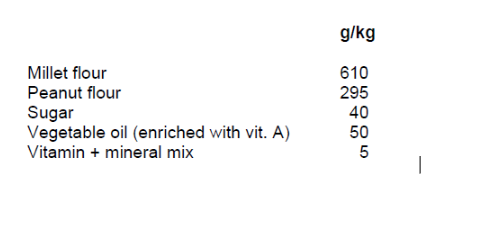
Preparation The sugar and flour is mixed. 945 g of dry mix for every 1 kg of supplement that has been blended with 5 g of the micronutrient powder and 50 g of the enriched vegetable oil. Per infant, per day needs 120 g of serving irrespective of age. Anthropometric data The data collected in baseline and follow up are the followings
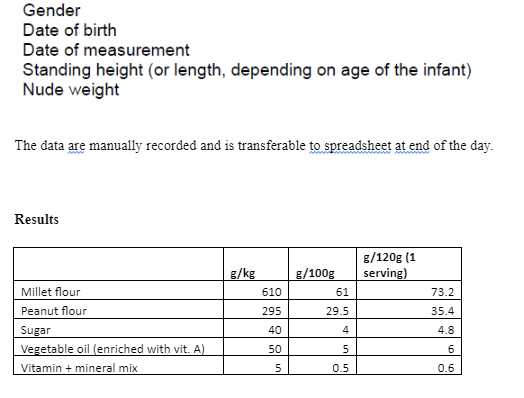
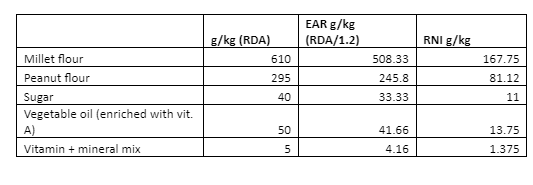
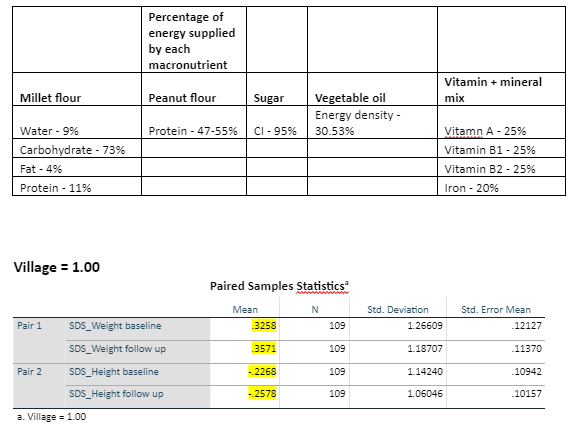
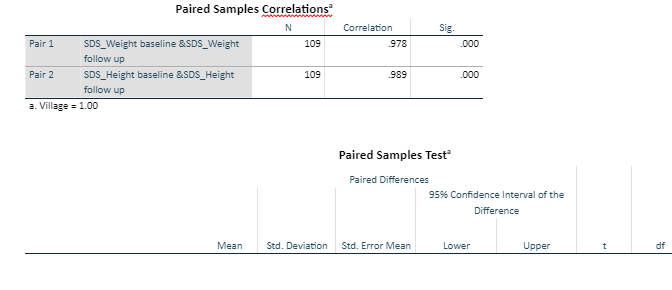
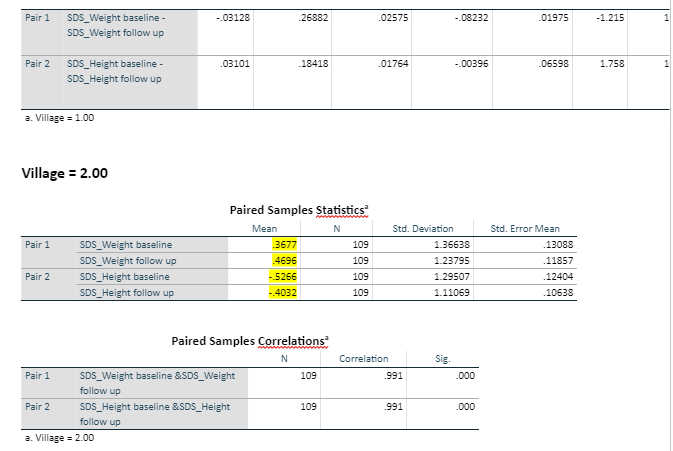
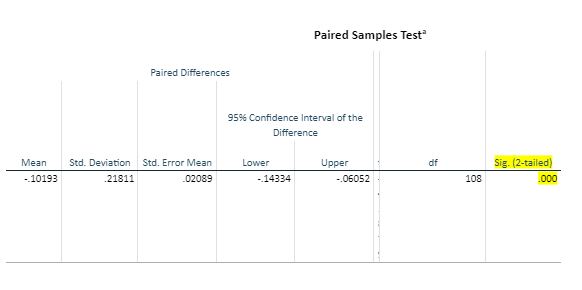

Discussion
In the both first part and second part, SDS mean weight and height has increased marginally. This leads to the evaluation that there is low impact as result of the intervention (Hurrell et al., 2003). The correlation is also very high between the SDS Weight baseline and SDS Weight follow up which means that impact is marginal. Similarly the correlation is also very high between the SDS Height baseline and SDS Height follow up which means that impact is marginal. In case of SDS Weight SD of 0.26 above mean indicates that weight of the children is above the 2nd centile. The cut off point for the underweight is 2nd centile. Therefore, since, the SDS Weight is above that threshold itself indicates that the intervention has positive impact in terms of the weight of the participants albeit small (Boelaert et al., 1995). In case of SDS Height SD of 0.18 above mean indicates that height of the children is below the 2nd centile. Thus, this figure indicates that the intervention’s impact in case of height of the participants is below the threshold. Village 2 In the first part, the SDS mean weight increased considerably. Thus, it indicates that intervention’s impact is positive and reasonably high. However, in the second part, SDS Mean Height decreased considerably. Thus, intervention in case of participant’s height is unsuccessful. The correlation is also very high between the SDS Weight baseline and SDS Weight follow up indicating that if weight increases in the baseline, the weight will also increase in the follow up by almost equal proportion. Similarly, the correlation is also very high between the SDS Height
baseline and SDS Height follow up indicating that if height increases in the baseline, the height will also increase in the follow up by almost equal proportion. In case of SDS Weight SD of 0.21 above mean indicates that weight of the children is above the 2nd centile. The cut off point for the underweight is 2nd centile. Therefore, since, the SDS Weight s above that threshold itself indicates that the intervention has positive impact in terms of the weight of the participants albeit very small. In case of SDS Height SD of 0.24 above mean indicates that weight of the children is above the 2nd centile. The cut off point for the underweight is 2nd centile (Briend, et al., 2003). Therefore, since, the SDS Height s above that threshold itself indicates that the intervention has positive impact in terms of the weight of the participants albeit small (Ahmed et al., 1999). The EAR can be estimated as the mean requirement of the nutrient or energy that a group of people needs. This means that around half the people shall be requiring less and the rest half will be requiring more (Hauber et al., 1997). This means that 50% of the participants will need more than 508 g of millet flour and 50% of the participants will need less than 508 g of millet flour. Much in the same way, 50% of the participants will need more than 245 g of peanut flour, 33 g of sugar, 41 l of vegetable oil, and 4 g of vitamin and mineral mix as 50% of the participants will be needing less of these amounts. RNI is the nutrient amount which is enough in ensuring that needs of 97.5% of the people are met (Hauber et al., 1997). Thus, 167.75 g of millet flour, 81.12 g of peanut flour, 11 g of sugar, 13.75 l of vegetable oil and 1.3 g of vitamin and mineral mix is enough in ensuring that needs of 97.5% of the participants are met.
Conclusion
The impact of the intervention was largely positive except for the participants’ height in the village 2. However, the positive impact was not very substantial throughout except for participant weight in the village 2.

References
- Coward, A. (1998) ‘Contributions of the doubly labelled water method to studies of energy balance in the Third World’, Am. J. Clin. Nutr., 68 (suppl.): 962S–969S.
- Food and Nutrition Board/Institute of Medicine. (2002) Dietary reference intakes for energy, carbohydrate, fiber, fat, fatty acids, cholesterol, protein, and amino acids, Institute of Medicine of the National Academies, Washington, DC, National Academy Press.
- Hauber, U., Bruce, A. and Neuhäuser-Berthold, M. (1997) ‘A comparison of dietary reference values for energy of different countries’, Z Ernahrungswiss, 36: 394–402.
- Henry, C.J.K. (2001) ‘Basal metabolic rate studies in humans: measurement and application’, Background document prepared for the joint FAO/WHO/UNU Expert Consultation on Energy in Human Nutrition, 2001.
- Ashworth, A. (2009) ‘Ferguson E. Dietary counseling in the management of moderate malnourishment in children’, Food Nutr Bull, 30:S406–33.
- Briend, A., Lacsala, R., Prudhon, C., Mounier, B., Grellety, Y. and Golden, M. H. (1999) ‘Ready-to-use therapeutic food for treatment of marasmus’, Lancet, 353:1767–1768.
- Bryce, J., Coitinho, D., Darnton-Hill, I., Pelletier, D. and Pinstrup-Andersen, P. (2008) ‘Maternal and Child Undernutrition Study Group. Maternal and child undernutrition: effective action at national level’, Lancet, 371:510–526.
- Cook, R. (1971) ‘Is hospital the place for the treatment of malnourished children?’, J Trop Pediatr Environ Child Health, 17:15–25.
- Deen, J. L., et al. (2003) ‘Implementation of WHO guidelines on management of severe malnutrition in hospitals in Africa’, Bull World Health Organ., 81:237–243.
- Getahun, Z., Urga, K., Genebo, T. and Nigatu, A. (2011) ‘Review of the status of malnutrition and trends in Ethiopia’, Ethiop J Heal Dev., 15: 55–74.
- Golden, M. H. (2009) ‘Proposed recommended nutrient densities for moderately malnourished children’, Food Nutr Bull, 30:S267–343.
- Hoppe, C., Jacobsen, S., Molgaard, C., Friis, H., Sangild, P. T. and Michaelsen, K. F. (2008) ‘The use of whey protein or skimmed milk powder in fortified blended foods for vulnerable groups; a literature review’, J Nutr, 138:145S–61S.
- Michaelsen, K. F., Hoppe, C., Roos, N., Kaestel, P., Stougaard, M., Lauritzen, L., Molgaard, C., Girma, T. and Friis, H. (2009) ‘Choice of foods and ingredients for moderately malnourished children 6 months to 5 years of age’, Food Nutr Bull, 30:S344–405.
- Zimmermann, M. B. (2007) ‘Nutritional iron deficiency’, Lancet, 370:511–20.
- Dewey, K. G. and Adu-Afarwuah, S. (2008) ‘Systematic review of the efficacy and effectiveness of complementary feeding interventions in developing countries’. Maternal Child Nutr, 4:24–85.
- Hotz, C. and Gibson, R. S. (2007) ‘Traditional food-processing and preparation practices to enhance the bioavailability of micronutrients in plant-based diets’, J Nutr, 137:1097–100.
- Hurrell, R. F., Reddy, M. B., Juillerat, M. A. and Cook, J. D. (2003) ‘Degradation of phytic acid in cereal porridges improves iron absorption by human subjects’, Am J Clin Nutr, 77:1213–9.
- Boelaert, M., Davis, A., Le, L. B., et al.(1995) ‘Nutrition guidelines’, 1st. Paris: Medecins sans Frontieres.
- Ahmed, T., Ali, M., Ullah, M. M., et al. (1999) ‘Mortality in severely alnourished children with diarrhoea and use of a standardised management protocol’, Lancet., 353:1919–1922.
- Briend, A. (2003) ‘Trial and error methods, “expert” guessing or linear programming? Formulating sound nutritional recommendations for complementary feeding’, SCN News, 7:36–9.
Dig deeper into Mary Ainsworth's Strange Situation Procedure with our selection of articles.
- 24/7 Customer Support
- 100% Customer Satisfaction
- No Privacy Violation
- Quick Services
- Subject Experts



